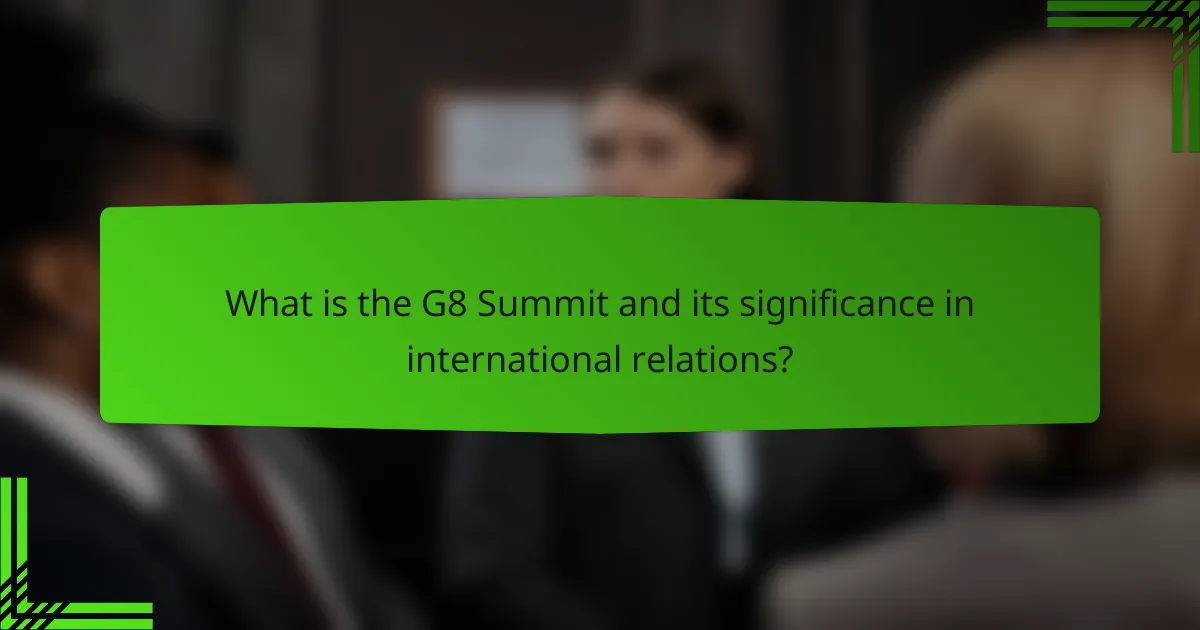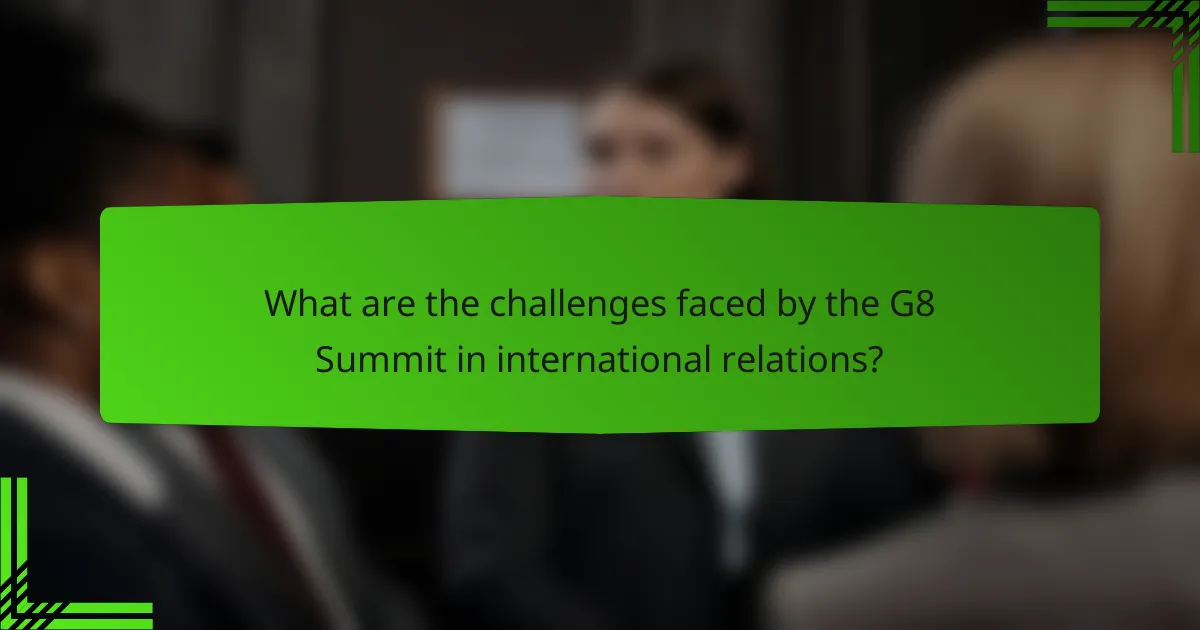The G8 Summit is an annual meeting of the leaders from eight major industrialized nations: Canada, France, Germany, Italy, Japan, Russia, the United Kingdom, and the United States. This summit addresses critical global economic issues, security challenges, and facilitates international cooperation and policy coordination. The G8 Summit plays a significant role in shaping global economic policies, influencing trade agreements, and responding to pressing issues such as climate change and terrorism. However, it faces challenges including differing national priorities, the rise of emerging economies, and questions regarding its legitimacy and representation of the broader international community. The outcomes of the G8 Summit can lead to significant changes in diplomatic strategies and international relations.

What is the G8 Summit and its significance in international relations?
The G8 Summit is an annual meeting of the leaders of eight major industrialized nations. These nations include Canada, France, Germany, Italy, Japan, Russia, the United Kingdom, and the United States. The summit addresses global economic issues and security challenges. It serves as a platform for discussing international cooperation and policy coordination.
The significance of the G8 Summit in international relations lies in its ability to shape global economic policies. It influences international trade agreements and economic reforms. The summit also addresses pressing global issues like climate change and terrorism. Through dialogue, member countries can align their strategies and respond to crises collectively.
The G8 Summit’s decisions can lead to significant changes in international relations. For example, agreements made at the summit can affect global markets and political dynamics. The summit provides a unique opportunity for leaders to engage in direct communication. This fosters diplomatic relationships and can lead to collaborative efforts on international challenges.
How did the G8 Summit originate and evolve over time?
The G8 Summit originated in 1975 as a forum for the leaders of the world’s major industrialized nations. Initially, it included six countries: France, Germany, Italy, Japan, the United Kingdom, and the United States. Canada joined in 1976, expanding the group to seven. Russia was invited in 1997, creating the G8. The summit aimed to address global economic issues and foster cooperation among these nations. Over time, its focus expanded to include political and social issues, such as climate change and security. The G8 Summit evolved through various formats and agendas, reflecting changing global dynamics. It faced challenges, including criticisms over its effectiveness and representation. In 2014, Russia was suspended due to its actions in Ukraine, reverting the group to the G7. The G8’s evolution illustrates shifts in global governance and international relations.
What were the initial goals of the G8 Summit?
The initial goals of the G8 Summit included fostering economic cooperation among industrialized nations. The summit aimed to address global economic issues and promote sustainable development. It also focused on enhancing security and stability in international relations. Another objective was to tackle pressing global challenges, such as poverty and health crises. The G8 sought to create a platform for dialogue among member countries. This included discussing trade policies and environmental concerns. The first summit was held in 1975, originally involving six nations. Canada joined in 1976, expanding the group to what became known as the G7, later including Russia.
How have the objectives of the G8 Summit changed?
The objectives of the G8 Summit have evolved significantly over the years. Initially, the G8 focused on economic issues and global economic governance. In recent years, the objectives have expanded to include climate change, security, and global health. The shift reflects changing global priorities and challenges. For example, the 2005 Summit emphasized global health initiatives, particularly in response to the HIV/AIDS crisis. The 2015 Summit highlighted climate change commitments, culminating in the Paris Agreement discussions. This evolution demonstrates the G8’s adaptation to contemporary global issues and the need for collaborative solutions.
What are the key functions of the G8 Summit?
The G8 Summit serves as a platform for leaders of eight major economies to discuss global issues. It focuses on economic policy coordination among member nations. The summit addresses security concerns, including terrorism and nuclear proliferation. It promotes collaboration on climate change and sustainable development. The G8 also facilitates dialogue on health issues, such as pandemics and global health initiatives. Furthermore, it encourages trade discussions and investment opportunities among the member states. The summit’s decisions influence international policies and set agendas for global governance. Established in the 1970s, the G8 has evolved to address emerging challenges in international relations.
How does the G8 Summit facilitate dialogue among member nations?
The G8 Summit facilitates dialogue among member nations through structured discussions and collaborative initiatives. It provides a platform for leaders to address global issues collectively. The summit encourages consensus-building on economic, security, and environmental challenges. Each meeting allows for the exchange of ideas and perspectives. Member nations share best practices and strategies for addressing common problems. The G8 also promotes bilateral meetings during the summit, enhancing direct communication. This structure fosters trust and strengthens diplomatic relationships. Historical data shows that the G8 has addressed critical issues like climate change and economic instability through these dialogues.
What role does the G8 Summit play in addressing global issues?
The G8 Summit plays a crucial role in addressing global issues through high-level discussions among major economies. It facilitates dialogue on pressing challenges such as economic stability, security, and climate change. The summit allows member countries to coordinate policies and share best practices. For instance, the 2005 summit focused on Africa’s development and health issues, resulting in significant commitments to aid. Additionally, the G8 Summit promotes collaboration on counter-terrorism and non-proliferation efforts. Meetings often yield joint statements that reflect a unified stance on global matters. The G8 has historically influenced international norms and frameworks, shaping responses to crises. Through these mechanisms, the G8 Summit remains a pivotal platform for global governance.

How does the G8 Summit influence diplomatic strategies?
The G8 Summit influences diplomatic strategies by providing a platform for dialogue among major world leaders. This summit facilitates discussions on global issues such as trade, security, and climate change. The outcomes can shape bilateral and multilateral agreements. For instance, the G8 has historically addressed economic crises, leading to coordinated responses among member nations. The summit promotes consensus-building, which can lead to unified stances on international policies. Additionally, the G8 allows for the establishment of informal networks among leaders. These networks often influence policymaking beyond the summit itself. The collaborative nature of the G8 fosters trust and enhances diplomatic relations among member states.
What diplomatic strategies are employed during the G8 Summit?
The G8 Summit employs various diplomatic strategies to facilitate international cooperation. These strategies include consensus-building, where member countries negotiate to reach common agreements. Another strategy is agenda-setting, which involves prioritizing global issues for discussion, such as economic stability and climate change.
Additionally, bilateral meetings often occur alongside the main summit, allowing leaders to address specific concerns directly. The use of informal discussions fosters open dialogue and relationship-building among leaders.
Moreover, joint declarations are crafted to communicate unified stances on pressing issues. These strategies are essential for enhancing collaboration and addressing global challenges effectively. The G8 Summit’s diplomatic approach has historically led to significant agreements, such as the 2009 commitment to combat the global financial crisis.
How do member countries negotiate and reach consensus?
Member countries negotiate and reach consensus through structured dialogues and diplomatic discussions. They hold meetings to address key issues and share perspectives. Each country presents its interests and concerns. Negotiators aim to find common ground among diverse viewpoints. Consensus is often achieved through compromise and collaboration. Formal agreements may be drafted to reflect mutual understanding. The process is guided by established protocols and frameworks. Historical examples show that consensus-building is critical for effective international cooperation.
What impact do these strategies have on global diplomacy?
These strategies enhance global diplomacy by fostering collaboration among nations. They facilitate dialogue on pressing issues such as climate change, security, and economic stability. The G8 Summit serves as a platform for leaders to discuss and coordinate their responses. This collaboration can lead to joint initiatives and agreements that strengthen international ties. For example, the G8’s commitment to combating poverty has resulted in programs that support developing countries. Such initiatives showcase the effectiveness of diplomatic strategies in addressing global challenges. Moreover, these strategies can influence global governance by setting agendas that other nations follow. Overall, they play a crucial role in shaping a cooperative international environment.
How does the G8 Summit foster international alliances?
The G8 Summit fosters international alliances by providing a platform for dialogue among major world economies. It brings together leaders from eight influential countries to discuss global issues. These discussions often lead to collaborative agreements and shared policies. The summit encourages cooperation on economic, security, and environmental challenges. By addressing these topics, member countries strengthen their diplomatic ties. The G8 also facilitates networking opportunities for leaders and officials. This networking can result in bilateral agreements outside the summit. Historical summits have led to significant partnerships, such as those formed after the 2009 summit addressing the global financial crisis.
What types of alliances are formed during the G8 Summit?
The G8 Summit fosters several types of alliances, primarily economic, political, and security alliances. Economic alliances focus on trade agreements and financial cooperation among member states. Political alliances often address global governance issues, such as climate change and human rights. Security alliances emphasize collective defense and counter-terrorism efforts. Historical examples include the 2005 Gleneagles Summit, which prioritized debt relief for Africa, showcasing economic collaboration. The 2016 Summit in Japan highlighted political unity against terrorism. Thus, the G8 Summit plays a crucial role in forming diverse alliances that address global challenges.
How do these alliances shape international relations?
Alliances significantly shape international relations by fostering cooperation among member states. They create a framework for collective security and diplomatic engagement. For example, NATO enhances military collaboration, deterring potential aggressors. Economic alliances, such as the European Union, facilitate trade and investment, promoting stability. These alliances also influence global governance by establishing norms and standards. The G8 Summit exemplifies how diplomatic strategies can address global challenges. Through dialogue, member nations align their policies on issues like climate change and security. This collaborative approach strengthens the international community’s response to crises. Ultimately, alliances play a crucial role in shaping the geopolitical landscape.

What are the challenges faced by the G8 Summit in international relations?
The G8 Summit faces several challenges in international relations. One major challenge is the differing priorities of member countries. Each nation has unique economic and political interests. This often leads to conflicts in agenda setting. Another challenge is the rise of emerging economies. Countries like China and India are not part of the G8. Their growing influence complicates global discussions. Additionally, global issues such as climate change and security threats require unified action. However, consensus among G8 members is often difficult to achieve. Historical tensions, such as those between Russia and Western nations, further strain cooperation. Lastly, public perception and legitimacy are increasingly questioned. Critics argue that the G8 does not represent the broader international community. These factors collectively hinder the effectiveness of the G8 Summit in addressing global challenges.
What criticisms have been directed at the G8 Summit?
Criticisms directed at the G8 Summit include concerns about its exclusivity. Many argue that the G8 does not represent the broader international community. Critics highlight the lack of input from developing nations. This can lead to policies that do not address global inequalities. Environmental issues are often inadequately addressed during discussions. Activists claim that the summit prioritizes economic interests over social justice. Additionally, the effectiveness of G8 resolutions is questioned. Some assert that commitments made are frequently unfulfilled.
How do these criticisms affect the credibility of the G8 Summit?
Criticisms of the G8 Summit significantly undermine its credibility. When member nations fail to address pressing global issues, public trust diminishes. For example, criticism regarding inaction on climate change has led to skepticism about the summit’s effectiveness. Studies show that perceived ineffectiveness can reduce international cooperation. Additionally, allegations of exclusivity suggest that the G8 does not represent global interests. This perception can alienate non-member countries and weaken diplomatic ties. Ultimately, ongoing criticisms can lead to decreased participation and engagement from key stakeholders in international relations.
What reforms have been proposed to address these challenges?
Proposed reforms to address challenges in international relations include enhancing multilateral cooperation among G8 nations. These reforms aim to improve communication and coordination on global issues. Strengthening the G8’s decision-making processes is also suggested to ensure timely responses to crises. Additionally, integrating emerging economies into discussions is seen as vital for inclusive policy-making. Expanding the agenda to include climate change and security is another proposed reform. These changes are necessary to adapt to the evolving geopolitical landscape. They reflect a commitment to fostering collaboration and addressing global challenges effectively.
How does the G8 Summit adapt to changing global dynamics?
The G8 Summit adapts to changing global dynamics by evolving its agenda to address emerging issues. This includes incorporating topics like climate change, global health, and cybersecurity. The G8 leaders recognize the importance of collaboration in tackling these challenges. For example, the 2015 summit in Germany focused on refugee crises and sustainable development. Additionally, the G8 engages with non-member countries and international organizations to broaden its influence. This approach allows the summit to remain relevant in a multipolar world. The G8’s adaptability is crucial for fostering global cooperation.
What role do emerging economies play in the future of the G8 Summit?
Emerging economies play a significant role in shaping the future of the G8 Summit. Their growing economic power influences global discussions and decision-making. Countries like India, Brazil, and China represent a substantial portion of the world’s population and GDP. Their participation can enhance the legitimacy and relevance of the G8. Emerging economies often advocate for issues like climate change and sustainable development. This aligns with global priorities and reflects changing power dynamics. As these economies continue to grow, their voices will become increasingly important in international forums. Their inclusion can foster more inclusive and representative global governance.
How is the G8 Summit responding to global crises?
The G8 Summit addresses global crises through collective dialogue and policy coordination. Leaders from member nations convene to discuss pressing issues such as climate change, economic instability, and security threats. They agree on joint initiatives to enhance cooperation in response to these challenges. For instance, the G8 has made commitments to combat pandemics by increasing funding for health systems. Additionally, they have established frameworks for economic recovery during financial downturns. The G8 also emphasizes the importance of sustainable development in crisis response strategies. These efforts reflect a unified approach to tackling complex global issues effectively.
What best practices can enhance the effectiveness of the G8 Summit?
Establishing clear agendas enhances the effectiveness of the G8 Summit. Specific goals guide discussions and keep participants focused. Regular follow-ups on previous commitments ensure accountability among member countries. Engaging civil society and experts fosters diverse perspectives and innovative solutions. Utilizing technology for real-time communication improves coordination and information sharing. Encouraging consensus-building through informal dialogues promotes collaboration and trust. Lastly, assessing outcomes through transparent evaluations strengthens future summits. These practices have been shown to improve decision-making and strengthen international relations.
The G8 Summit is an annual meeting of leaders from eight major industrialized nations, including Canada, France, Germany, Italy, Japan, Russia, the United Kingdom, and the United States. This article explores the significance of the G8 Summit in shaping international relations through its diplomatic strategies and alliances. It examines the summit’s origins, evolving objectives, key functions, and the challenges it faces, including criticisms regarding its exclusivity and effectiveness. Additionally, the article discusses how the G8 Summit adapts to changing global dynamics and the role of emerging economies in its future, highlighting best practices that can enhance its effectiveness in addressing global challenges.